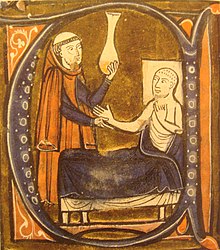Urine glass

The urinal or Harnglas also Matula ( lat. "Pot", "washing dishes", " night Kitchen ") Harnschauglas or urinal (from Latin. Urina "urine") is a historical Harnprobengefäß glass for the urine inspection and belonged for centuries to the recognition mark of the medical profession.
The urine glass is a round flask - to pear-shaped glass vessel with a funnel-shaped opening - a container similar to a bulbous coachman's glass with a wider neck. Some specimens had a flat base to stand on, most had a curved base and required a support container (usually a basket or wooden frame) to prevent them from tipping over. The collected in this vessel morning urine was the urine (be) chill brought - a doctor or medical skilled and precursors of urologists , the sample according to the Humoralpathologie to density , color, odor, taste and sediment (lat. Contenta "ingredients") reviewed and the finding , which was evaluated in connection with other medical data of the patient, entered on the urine card . For some investigations, a screw dropper was attached, which made it possible to only take amounts drop by drop.
The matula as a status symbol of the doctor and a symbol for a diagnostic method that was considered universal (for almost all diseases) and infallible at the time can still be found today in the signs of various urological societies , e.g. B. the German Society for Urology , the Professional Association of German Urologists and the American Society for Urology .
In printed medical textbooks there are hand-painted illustrations that depict the doctor with a urine glass in hand with a work by Pietro d'Abano published in Mantua in 1472 .
literature
- Friedrich v. Zglinicki : Uroscopy in the fine arts. An art and medical historical study of the urine examination. GIT Verlag Ernst Giebler, Darmstadt 1982, ISBN 3-921956-24-2 , passim.
Individual evidence
- ^ Karl Sudhoff : Urinary glass and urinary glass basket. Something from the ABC of medical science of the Middle Ages. In: Sudhoffs Archiv 17, 1925, pp. 292–298.
- ↑ Friedrich v. Zglinicki (1982), especially p. 19 f.
- ↑ Carl Gustav Jung : Man and his symbols. 1968.
- ↑ German Society for Urology .
- ^ American Urological Association, AUA .
- ↑ Friedrich v. Zglinicki: Uroscopy in the fine arts. An art and medical historical study of the urine examination. 1982, p. 46.
